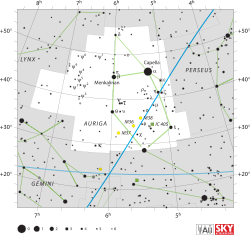Nu Aurigae

| |
| Observation data Epoch J2000 Equinox J2000 | |
|---|---|
| Constellation | Auriga |
| Right ascension | 05h 51m 29.40040s[1] |
| Declination | +39° 08′ 54.5428″[1] |
| Apparent magnitude (V) | 3.957[2] |
| Characteristics | |
| Spectral type | G9.5 III Fe1 Ba0.2 + wd[3] |
| U−B color index | +1.084[2] |
| B−V color index | +1.138[2] |
| R−I color index | 0.56 |
| Astrometry | |
| Radial velocity (Rv) | +9.92 ± 0.14[4] km/s |
| Proper motion (μ) | RA: +8.48[1] mas/yr Dec.: +0.39[1] mas/yr |
| Parallax (π) | 15.17 ± 0.88[1] mas |
| Distance | 220 ± 10 ly (66 ± 4 pc) |
| Details | |
| Radius | 19[4] R☉ |
| Luminosity | 135[4] L☉ |
| Surface gravity (log g) | 2.4[4] cgs |
| Temperature | 4,571[4] K |
| Metallicity [Fe/H] | –0.14[4] dex |
| Rotational velocity (v sin i) | 5.0[4] km/s |
| Other designations | |
Nu Aurigae (ν Aur, ν Aurigae) is the Bayer designation for a star in the northern constellation of Auriga. It is visible to the naked eye with an apparent visual magnitude of 3.96[2] and is approximately 220 light-years (67 parsecs) distant from the Earth. This is an evolved giant star with a stellar classification of G9.5 III.[6] It is a red clump star, which indicates that it is generating energy through the fusion of helium at its core.[7] The outer envelope has expanded to 19 times the radius of the Sun and cooled to 4,571 K,[4] giving it the characteristic yellow-hued glow of a G-type star. It shines with 135 times the luminosity of the Sun.[4]
This is an astrometric binary with a suspected white dwarf companion.[3] A 10th magnitude star 54.6 arcseconds away is an optical companion.
References
- 1 2 3 4 5 van Leeuwen, Floor (November 2007), "Validation of the new Hipparcos reduction", Astronomy and Astrophysics, 474 (2): 653–664, arXiv:0708.1752v1
 , Bibcode:2007A&A...474..653V, doi:10.1051/0004-6361:20078357. Note: see VizieR catalogue I/311.
, Bibcode:2007A&A...474..653V, doi:10.1051/0004-6361:20078357. Note: see VizieR catalogue I/311. - 1 2 3 4 Oja, T. (August 1986), "UBV photometry of stars whose positions are accurately known. III", Astronomy and Astrophysics Supplement Series, 65 (2): 405–409, Bibcode:1986A&AS...65..405O.
- 1 2 Eggleton, P. P.; Tokovinin, A. A. (September 2008), "A catalogue of multiplicity among bright stellar systems", Monthly Notices of the Royal Astronomical Society, 389 (2): 869–879, arXiv:0806.2878
 , Bibcode:2008MNRAS.389..869E, doi:10.1111/j.1365-2966.2008.13596.x.
, Bibcode:2008MNRAS.389..869E, doi:10.1111/j.1365-2966.2008.13596.x. - 1 2 3 4 5 6 7 8 9 Massarotti, Alessandro; et al. (January 2008), "Rotational and Radial Velocities for a Sample of 761 HIPPARCOS Giants and the Role of Binarity", The Astronomical Journal, 135 (1): 209–231, Bibcode:2008AJ....135..209M, doi:10.1088/0004-6256/135/1/209.
- ↑ "32 Aur -- Star in double system", SIMBAD Astronomical Database, Centre de Données astronomiques de Strasbourg, retrieved 2012-08-19.
- ↑ Eggen, O. J. (1962), "Space-velocity vectors for 3483 stars with proper motion and radial velocity", Royal Observatory Bulletin, 51, Bibcode:1962RGOB...51...79E.
- ↑ Valentini, M.; Munari, U. (November 2010), "A spectroscopic survey of faint, high-Galactic-latitude red clump stars. I. The high resolution sample", Astronomy and Astrophysics, 522: A79, arXiv:1007.0207
 , Bibcode:2010A&A...522A..79V, doi:10.1051/0004-6361/201014870.
, Bibcode:2010A&A...522A..79V, doi:10.1051/0004-6361/201014870.